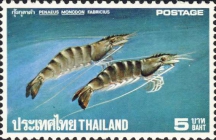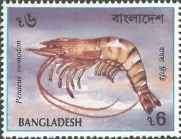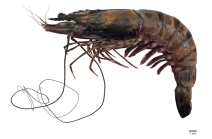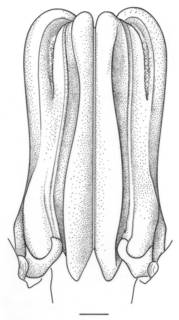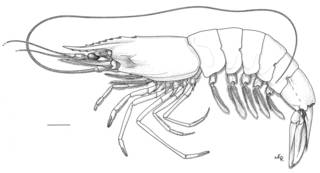
| Intro | | Search taxa | | Browse taxa | | Distributions | | Terminology | | References | | Statistics | | Online sources | | Tutorial | | Log in |
WoRMS name detailsPenaeus monodon Fabricius, 1798
210378 (urn:lsid:marinespecies.org:taxname:210378)
unaccepted > superseded combination
Species
Penaeus bubulus Kubo, 1949 · unaccepted > junior subjective synonym
Penaeus caeruleus Stebbing, 1905 · unaccepted > junior subjective synonym
Penaeus carinatus Dana, 1852 · unaccepted > junior subjective synonym
Penaeus durbani Stebbing, 1917 · unaccepted > junior subjective synonym
Penaeus manilensis Marion de Procé, 1822 · unaccepted > junior subjective synonym
Penaeus semisulcatus var. exsulcatus Hilgendorf, 1879 · unaccepted > junior subjective synonym
marine, brackish,
recent only
Fabricius, J.C. (1798). Supplementum Entomologiae Systematicae. Hafniae: Proft et Storck: 1-572., available online at https://www.biodiversitylibrary.org/page/25565932 [details]
Neotype , geounit Jakarta Bay
Neotype, geounit Jakarta Bay [details]
DecaNet eds. (2025). DecaNet. Penaeus monodon Fabricius, 1798. Accessed through: World Register of Marine Species at: https://www.marinespecies.org/aphia.php?p=taxdetails&id=210378 on 2025-05-04
Date action by
Nomenclatureoriginal description
Fabricius, J.C. (1798). Supplementum Entomologiae Systematicae. Hafniae: Proft et Storck: 1-572., available online at https://www.biodiversitylibrary.org/page/25565932 [details] basis of record Fischer, W.; Bianchi, G. (1984). FAO Species identification sheets For Fisheries Purposes: Western Indian Ocean. <em>FAO, Rome.</em> [details] Othercontext source (Introduced species)
Fofonoff, P.W.; Ruiz, G.M.; Steves, B.; Carlton, J.T. (2014-2024). National Exotic Marine and Estuarine Species Information System (NEMESIS). , available online at http://invasions.si.edu/nemesis [details]
context source (HKRMS) City University of Hong Kong. (2010). Provision of Services for Species Identification and Data Analysis of Epibenthic Organisms from Hong Kong Water. Final report. Environmental Protection Department. Department of Biology and Chemistry, City University [details] additional source Pérez Farfante, I.; Kensley, B. (1997). Penaeoid and sergestoid shrimps and prawns of the world. Keys and diagnoses for the families and genera. <em>Mémoires du Muséum National d'Histoire naturelle.</em> 175: 1-233. [details] Available for editors additional source Felder, D. L., Álvarez. F.,Goy, J.W. & Lemaitre, R. (2009). Decapoda (Crustacea) of the Gulf of Mexico, with comments on the Amphionidacea,. <em>Felder, D.L., and Camp, D.K. (eds), Gulf of Mexico - Origins, Waters, and Biota. Vol. 1. Biodiversity.</em> Pp. 1019–1104 (Texas A&M University Press: College Station, Texas)., available online at http://biogomx.net/sites/default/files/pdfs/chapters/59-Felder%20et%20al%202009-Decapoda%20of%20the%20GoMx.pdf [details] additional source Liu, J.Y. [Ruiyu] (ed.). (2008). Checklist of marine biota of China seas. <em>China Science Press.</em> 1267 pp. (look up in IMIS) [details] Available for editors additional source De Grave, S.; Fransen, C.H.J.M. (2011). Carideorum catalogus: the recent species of the dendrobranchiate, stenopodidean, procarididean and caridean shrimps (Crustacea: Decapoda). <em>Zoologische Mededelingen, Leiden.</em> 85(9): 195-589. (look up in IMIS) [details] additional source Holthuis, L.B., 1949a. The identity of Penaeus monodon Fabr.— Proceedings van de Koninklijke Nederlandsche Akademie van Wetenschappen 52: 1051-1057. [details]  Present Present  Present in aphia/obis/gbif/idigbio Present in aphia/obis/gbif/idigbio  Inaccurate Inaccurate  Introduced: alien Introduced: alien  Containing type locality Containing type locality
Neotype, geounit Jakarta Bay [details]
From regional or thematic species database
Introduced species abundance in United States part of the Gulf of Mexico (Marine Region) : Fourteen specimens were caught in Louisiana waters.Info retrieved from NEMESIS (Fofonoff, P.W.; Ruiz, G.M.; Steves, B.; Carlton, J.T. (2014). National Exotic Marine and Estuarine Species Information System) [details] Introduced species impact Chinese part of the South China Sea (Marine Region) Pathogen/parasite or carrier of a pathogen/parasite [details] Introduced species impact Chinese part of the Eastern Chinese Sea(Marine Region) Pathogen/parasite or carrier of a pathogen/parasite [details] Introduced species remark In Ecuador (Nation) : There are no reported impacts of P. monodon, but this species could compete with native shrimp, and may transmit viruses such as the White Spot Virus. [details] Introduced species remark In Nigerian part of the Gulf of Guinea : There are no reported impacts of P. monodon, but this species could compete with native shrimp, and may transmit viruses such as the White Spot Virus. [details] Introduced species remark In Venezuela (Nation) : There are no reported impacts of P. monodon, but this species could compete with native shrimp, and may transmit viruses such as the White Spot Virus. [details] Introduced species remark In Brazil (Nation) : There are no reported impacts of P. monodon, but this species could compete with native shrimp, and may transmit viruses such as the White Spot Virus. [details] Introduced species remark In Dominican Republic (Nation) : There are no reported impacts of P. monodon, but this species could compete with native shrimp, and may transmit viruses such as the White Spot Virus. [details] Introduced species vector dispersal United States part of the Gulf of Mexico (Marine Region) Natural dispersal [details] Introduced species vector dispersal United States part of the Gulf of Mexico (Marine Region) Aquaculture: accidental [details] Introduced species vector dispersal Chinese part of the South China Sea (Marine Region) Aquaculture [details] Introduced species vector dispersal Chinese part of the Eastern Chinese Sea(Marine Region) Aquaculture [details] Introduced species vector dispersal United States part of the North Atlantic Ocean (Marine Region) Natural dispersal [details] Introduced species vector dispersal United States part of the North Atlantic Ocean (Marine Region) Aquaculture: accidental [details] Introduced species vector dispersal United States part of the North Atlantic Ocean (Marine Region) Ships: accidental with ballast water, sea water systems, live wells or other deck basins [details] Introduced species vector dispersal United States part of the Gulf of Mexico (Marine Region) Ships: accidental with ballast water, sea water systems, live wells or other deck basins [details]
To Barcode of Life (153 barcodes)
To Biodiversity Heritage Library (21 publications) (from synonym Penaeus carinatus Dana, 1852) To Biodiversity Heritage Library (61 publications) To Biological Information System for Marine Life (BISMaL) To European Nucleotide Archive, ENA (Penaeus monodon) To FAO Cultured Aquatic species fact sheets To FAO Species fact sheets To GenBank (214277 nucleotides; 34188 proteins) To GenBank (214277 nucleotides; 34188 proteins) (from synonym Penaeus bubulus Kubo, 1949) To GenBank (214277 nucleotides; 34188 proteins) (from synonym Penaeus durbani Stebbing, 1917) To NMNH Extant Collection (IZ Penaeus monodon) To USNM Invertebrate Zoology Arthropoda Collection (23 records) (from synonym Penaeus carinatus Dana, 1852) To USNM Invertebrate Zoology Arthropoda Collection (25 records) To ITIS |
